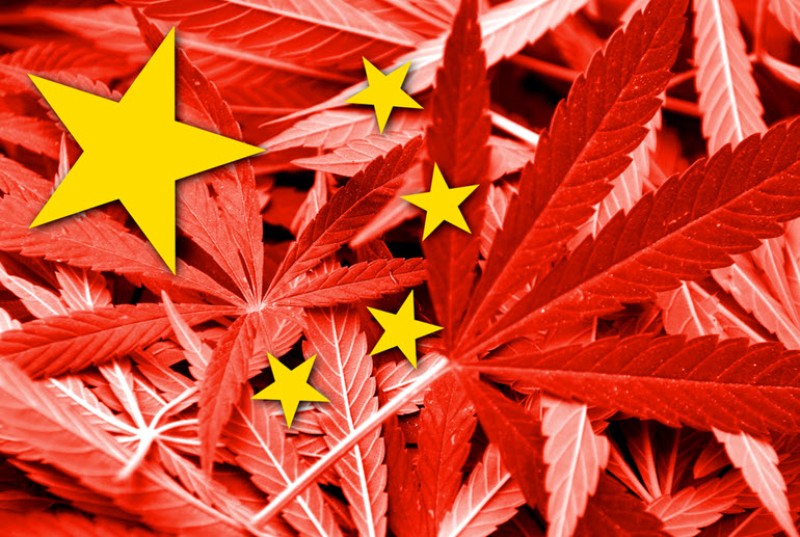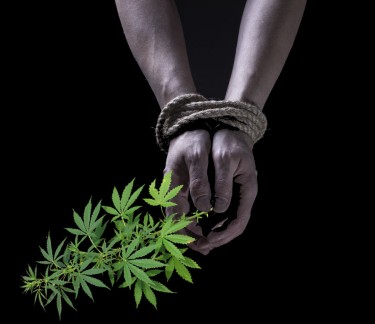
In the ongoing saga of drug prohibition, cannabis stands as a prime example of the unintended consequences that arise when governments attempt to suppress substances deemed illicit. The very act of prohibition, designed to reduce consumption, production, and distribution, has instead created a thriving black market that attracts criminal enterprises from around the globe.
When a substance is prohibited, it becomes contraband, inherently increasing its value to those willing to pay for it. This inflated value, in turn, entices individuals to risk their freedom to supply the illicit good. The result is a multi-billion dollar underground economy fueled by the illegal drug trade, with cannabis being one of its most lucrative commodities.
For decades, Mexican cartels dominated the illegal cannabis market in the United States. However, a new player has emerged on the scene, rapidly outpacing their predecessors: Chinese criminal organizations. These groups have established a network of illegal cannabis farms across the country, exploiting vulnerable workers and flooding the market with unregulated products.
In this article, we'll delve into the harrowing experience of one individual who escaped from a Chinese-run illegal cannabis farm, shedding light on the brutal realities of this underground industry. We'll explore the prevalence of these operations in the United States and examine how Chinese groups have managed to surpass Mexican cartels in the illegal cannabis trade.
Most importantly, we'll discuss how full-scale legalization and decriminalization of cannabis could effectively combat these illegal operations, protect workers, ensure product safety, and redirect billions of dollars from criminal enterprises to legitimate businesses and tax coffers. The story that follows serves as a stark reminder of the human cost of prohibition and the urgent need for comprehensive drug policy reform.
The Story of Lin
Lin's harrowing experience on an illegal Chinese-run cannabis farm in Oklahoma serves as a stark reminder of the dark underbelly of prohibition. As reported by The Frontier and ProPublica, Lin, a 44-year-old Chinese immigrant, found himself staring down the barrel of an AK-47 when he dared to demand unpaid wages from his ruthless employers. This terrifying incident forced Lin and his wife to flee to New York, but even three years later, the couple lives in constant fear of retribution.
Lin's story is not unique. He was one of several dozen Chinese immigrants working without pay on the farm, intimidated into silence by armed guards and violent managers. The farm's owner, Lamkam Ho, and manager, Zhixuan Hai, have since faced legal consequences for their involvement in marijuana trafficking and other crimes. However, the broader issue of exploitative labor practices in illegal cannabis operations persists.
What drives individuals like Lin to take such risks? For many, it's a combination of desperation and deception. Lin initially left China due to religious persecution, paying smugglers $50,000 to escape. When the pandemic disrupted his life in New York, the promise of work on cannabis farms seemed like a lifeline. But for others, the situation is even more dire. Many workers on these farms are victims of human trafficking, sold into modern-day slavery with little hope of escape.
The prevalence of Chinese-run illegal cannabis operations in the United States has skyrocketed in recent years. These criminal organizations have quickly outpaced Mexican cartels, establishing a vast network of illicit farms across multiple states. What's particularly alarming is the suspected connection between these criminal groups and the Chinese Communist Party (CCP).
This connection transforms the issue from a domestic law enforcement problem into a matter of national security. These operations aren't just flooding the U.S. market with unregulated cannabis; they're funneling billions of dollars out of the American economy and into the coffers of a foreign government. The scale of this problem is staggering, with thousands of Chinese immigrant laborers subjected to abuse and exploitation across the country.
The rapid expansion of Chinese-run cannabis farms in the U.S. has caught many by surprise. Law enforcement agencies, already stretched thin, struggle to keep up with the proliferation of these operations. The sophisticated nature of these criminal networks, often leveraging high-tech equipment and complex financial structures, makes them particularly challenging to combat.
Perhaps most troubling is the apparent inaction from politicians and policymakers. Whether due to ignorance, indifference, or more sinister motivations, the lack of decisive action against these operations is allowing the problem to grow unchecked. This inaction not only perpetuates human rights abuses but also poses a significant threat to America's economic and national security interests.
The story of Lin and the broader issue of Chinese-run illegal cannabis farms underscore the urgent need for comprehensive cannabis legalization and decriminalization. By bringing the industry into the light, we can eliminate the shadows where criminal enterprises thrive, protect vulnerable workers, ensure product safety, and redirect billions of dollars from illicit operations to legitimate businesses and tax revenue. The human cost of prohibition is too high, and the threats to national security too great, to continue down the current path. It's time for a dramatic shift in U.S. drug policy, one that prioritizes public health, worker safety, and national interests over outdated and ineffective prohibitionist approaches.
The Smoke Screen
Drug prohibition, while ostensibly aimed at reducing substance abuse and associated crimes, often serves as a smoke screen, obscuring far more insidious activities that thrive in its shadow. This veil of illegality doesn't just fail to curb drug use; it creates a fertile ground for a myriad of other criminal enterprises to flourish.
A prime example of this came to light in 2012 when major financial institutions like HSBC and Bank of America were implicated in large-scale money laundering operations tied to drug cartels. HSBC, for instance, admitted to laundering nearly $900 million for Mexico's notorious Sinaloa Cartel. Yet, the punishment for these banks amounted to little more than a slap on the wrist – fines that pale in comparison to the profits reaped from these illicit activities. This incident exposed how deeply entrenched drug money is in our global financial system, with some of the world's most respected banks willingly turning a blind eye to the source of billions of dollars.
Moreover, the focus on drug interdiction often diverts attention and resources from other serious crimes. Human trafficking, for instance, frequently operates under the cover of drug networks. While law enforcement agencies pour resources into drug busts, human traffickers exploit the chaos and corruption bred by prohibition to conduct their operations with relative impunity. The result is a cruel irony: in our zeal to protect people from drugs, we inadvertently create conditions that subject many to modern-day slavery.
This reality underscores why drug legalization and regulation may be the most effective approach for the long-term well-being of society. While it's true that some drugs can have negative impacts on individuals and communities – alcohol being a prime example – the societal costs of regulated legal use are far outweighed by the violence, corruption, and human rights abuses that accompany prohibition.
We need only look at the history of alcohol prohibition in the United States to see this principle in action. The era of speakeasies and bootleggers was marked by a surge in organized crime, corruption, and violence. Once alcohol was relegalized and regulated, these problems didn't disappear overnight, but they were significantly reduced. The power of criminal organizations was diminished, and the government gained a new source of tax revenue.
By bringing the drug trade out of the shadows, we can redirect the flow of money from criminal enterprises back to legitimate businesses and public coffers. Instead of enriching cartels and fueling violence, drug revenues could fund education, healthcare, and addiction treatment programs. Regulation would also ensure product safety, reducing the risks associated with contaminated or adulterated substances.
Furthermore, legalization would free up vast law enforcement resources currently dedicated to fighting an unwinnable war on drugs. These resources could be redirected to combat more serious crimes, including human trafficking and other forms of exploitation that currently thrive in the chaos of the illegal drug trade.
The smoke screen of drug prohibition has allowed too many grave injustices to persist unchallenged. It's time to clear the air. By embracing a policy of legalization and regulation, we can strike at the heart of criminal enterprises, protect vulnerable populations, and create a safer, more just society. The choice is clear: we can continue to fight a losing battle against drugs, or we can take bold steps to address the real problems that prohibition has long obscured.
The Sticky Bottom Line
Lin's harrowing experience on an illegal Chinese-run cannabis farm in Oklahoma is not an isolated incident, but a stark illustration of a much larger, systemic problem. His story serves as a grim reminder of the human cost of our current drug policies, particularly cannabis prohibition. While Lin managed to escape, countless others remain trapped in similar situations, victims of a system that pushes an entire industry into the shadows.
The truth is, cannabis legalization - and indeed, the legalization of all drugs - is the only viable path forward if we truly want to address these issues. Prohibition has failed spectacularly in its stated goals of reducing drug use and associated crimes. Instead, it has created a thriving black market, fueled violence, enabled human trafficking, and allowed criminal enterprises to amass enormous wealth and power.
This October, the DEA aims to reschedule cannabis, potentially moving it from Schedule I to Schedule III. While this might seem like progress on the surface, it falls woefully short of what's needed. This half-measure will do nothing for people like Lin and millions of others caught in the crossfire of prohibition. It won't dismantle the illegal operations that exploit vulnerable workers, it won't ensure product safety for consumers, and it won't redirect the billions of dollars currently flowing into criminal enterprises.
What we need is a complete revamp of the system. Full legalization and regulation of cannabis - and eventually all drugs - would strip power from criminal organizations, protect workers, ensure product safety, generate tax revenue, and allow law enforcement to focus on real crimes like human trafficking. It would bring an entire industry out of the shadows and into the light of legal scrutiny and worker protections.
The sticky bottom line is this: our current approach to drug policy is not just failing - it's actively harmful. It creates more problems than it solves, victimizing vulnerable populations and enriching criminal enterprises. The story of Lin and countless others like him should serve as a wake-up call. It's time to abandon the failed policies of the past and embrace a new approach based on science, public health, and human rights.
Legalization is not just about the right to use cannabis or other substances. It's about dismantling a system that enables exploitation, violence, and corruption. It's about protecting vulnerable workers, ensuring consumer safety, and redirecting billions of dollars from criminal enterprises to public benefit. It's about recognizing that the "war on drugs" has been a war on people - particularly marginalized communities - and it's time for it to end.
As we move forward, let's keep Lin's story in mind. Let's remember that behind every illegal cannabis operation are real people suffering real harm. And let's commit to creating a system that prioritizes human dignity, public health, and social justice over outdated, ineffective, and harmful prohibitionist policies. The time for half-measures is over. The time for real, comprehensive drug policy reform is now.







